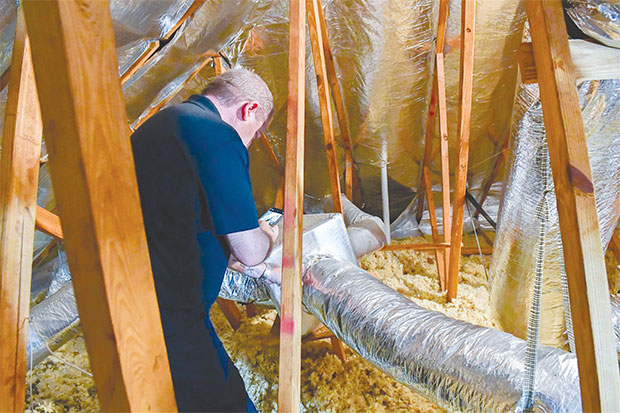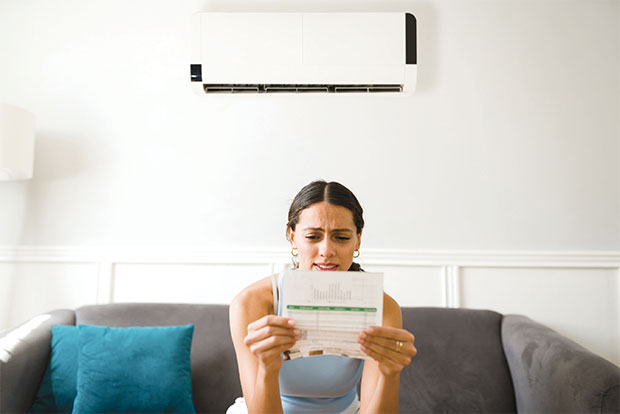Is it time to get your home’s ducts in order?
While homeowners invest time and money to make their homes comfortable and energy efficient, one common denominator of comfort and energy efficiency is often overlooked — the air inside a home. The old saying “what’s out of sight is out of mind” applies not only to a home’s air, but also to the attic ductwork that delivers air to every room. Damaged or leaky attic ductwork can provide a path for conditioned air to escape into the attic and for particulates in the attic’s air to be released into other parts of the home.
The typical duct system in an attic loses between 25% and 40% of the heating or cooling energy put out by the heating and cooling system, according to the U.S. Department of Energy. Air leakage can occur from holes in the attic ductwork or from poorly connected duct joints. As heated or cooled air is drawn into the attic space through holes and poor connections, energy dollars are used to heat or cool an unoccupied space. While heating and cooling bills will fluctuate according to changes in the weather pattern, an unexpected increase in energy bills may signal an issue with attic ducts.
Comparing a home’s energy usage to other similar-sized homes can also provide helpful insights about a home’s energy efficiency. Many utilities offer customers a report that shows how a home’s energy usage stacks up compared to other nearby homes of similar size. Heating or cooling bills that are higher than comparably sized homes in the area may indicate a problem with attic ducts.
An Owens Corning® Air CareTM contractor can identify problems with attic ductwork and recommend solutions to help improve comfort and reduce energy bills. Resolving problems with leaky ducts can also help curb the wear and tear on HVAC equipment, potentially extending its operational life and protecting the homeowner’s investment in a high-efficiency comfort system.
Beyond reducing energy efficiency, problems with attic ductwork can adversely affect the quality of indoor air. An increase in household dust is a common sign that attic ductwork may be compromised. Holes or poor connections in ductwork can allow particulates from the attic space to enter the ducts and flow into rooms throughout the home. Dust accumulation on return air registers or heavier levels of dust inside the home may suggest a problem with ductwork.
A home’s age may also suggest an inspection of attic ductwork. The ductwork in many older homes was installed in accordance with much lower residential building codes. Depending on when a home was built, there may have been no codes targeting energy efficiency.
Issues with ductwork may sometimes be detected with a visual inspection — for example, disconnected ducts near registers or holes, tears and loose joints. But many times, the issues are more difficult to detect. That’s why it’s important to have an inspection conducted by a qualified contractor.
Owens Corning® Air CareTM contractors are equipped with the training and tools to evaluate an attic duct system’s integrity and the overall efficiency of the duct system. The contractor will use a fan and pressure gauge to conduct a basic duct leakage test to measure the extent of leakage in ducts. Thermal cameras will visualize where air from the ducts is escaping into unconditioned parts of the home. The contractor will also assess the airflow rate as a duct system’s efficiency is affected by leakage as well as fan flow. Depending on the findings, the Owens Corning® Air CareTM contractor can recommend a solution to address duct issues that may involve repairing, sealing or replacing one or more sections of ductwork.
Beyond ensuring that ductwork is properly connected and in good condition, other steps can contribute to comfortable and energy-efficient environments. Installing a programmable thermostat can help reduce heating and cooling costs by turning up or down the temperature when occupants are not home. And finally, adequate levels of insulation inside the attic can help guard against heated air flowing into the attic in the winter, or hot attic air from entering air-conditioned parts of the home in the summer.
Considering the role that attic ductwork plays in supporting a home’s heating and cooling system, ensuring
that a home’s ducts are in order can help homeowners support optimal comfort, energy efficiency and their investment in a high-efficiency home comfort system.
This article is courtesy of Brandpoint.


